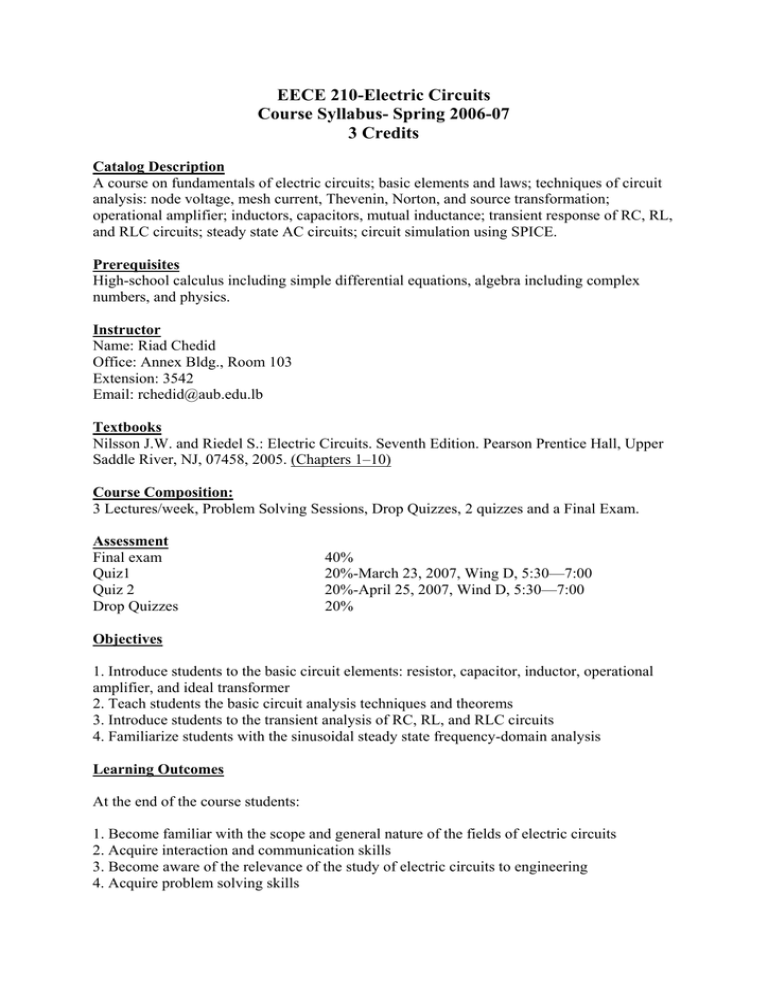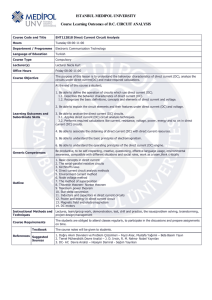
EECE 210-Electric Circuits
Course Syllabus- Spring 2006-07
3 Credits
Catalog Description
A course on fundamentals of electric circuits; basic elements and laws; techniques of circuit
analysis: node voltage, mesh current, Thevenin, Norton, and source transformation;
operational amplifier; inductors, capacitors, mutual inductance; transient response of RC, RL,
and RLC circuits; steady state AC circuits; circuit simulation using SPICE.
Prerequisites
High-school calculus including simple differential equations, algebra including complex
numbers, and physics.
Instructor
Name: Riad Chedid
Office: Annex Bldg., Room 103
Extension: 3542
Email: rchedid@aub.edu.lb
Textbooks
Nilsson J.W. and Riedel S.: Electric Circuits. Seventh Edition. Pearson Prentice Hall, Upper
Saddle River, NJ, 07458, 2005. (Chapters 1–10)
Course Composition:
3 Lectures/week, Problem Solving Sessions, Drop Quizzes, 2 quizzes and a Final Exam.
Assessment
Final exam
Quiz1
Quiz 2
Drop Quizzes
40%
20%-March 23, 2007, Wing D, 5:30—7:00
20%-April 25, 2007, Wind D, 5:30—7:00
20%
Objectives
1. Introduce students to the basic circuit elements: resistor, capacitor, inductor, operational
amplifier, and ideal transformer
2. Teach students the basic circuit analysis techniques and theorems
3. Introduce students to the transient analysis of RC, RL, and RLC circuits
4. Familiarize students with the sinusoidal steady state frequency-domain analysis
Learning Outcomes
At the end of the course students:
1. Become familiar with the scope and general nature of the fields of electric circuits
2. Acquire interaction and communication skills
3. Become aware of the relevance of the study of electric circuits to engineering
4. Acquire problem solving skills
5. Understand the fundamental laws of electrical circuit theory such as Ohm's law,
Kirchhoff's laws, mesh analysis, and nodal analysis to solve simple circuit problems
6. Are able to apply the fundamental laws and concepts in analyzing resistive circuits
containing controlled sources
7. Understand the concepts of maximum power transfer and of source transformation
8. Are able to determine individual linear responses using the superposition theorem
9. Are able to obtain Thevenin’s and/or Norton’s equivalent circuit models for active, one
port networks
10. Are able to apply delta – wye or wye – delta transformation as necessary to simplify
circuit analysis
11. Are able to identify and apply the most appropriate circuit analysis techniques and/or
theorems for specific types of circuits
12. Are able to define/explain the voltage – current relationship and stored energy in
inductors and in capacitors
13. Analyze and determine the complete response of RL, RC and RLC circuits
14. Are able to identify the frequency, amplitude, and phase of a sinusoidal voltage or
current.
15. Are able to calculate the impedance of a simple circuit consisting of resistors, inductors,
and/or capacitors.
16. Are able to calculate the power dissipated or supplied by an electrical component given
its voltage and current
17. Have a basic understanding of op-amps and their applications.
TOPICS:
(Weeks 1-2/ 4 lectures)
- Circuit variables: Nature and limitations of circuit analysis, voltage, current, and
power.
- Ideal circuit elements: Voltage and current sources, independent and dependent
sources, resistance.
- Basic laws: Ohm’s law and Kirchhoff’s laws.
- Simple resistive circuits: Series and parallel connections, current and voltage dividers
and measurement, the Wheatstone bridge, delta-to-wye equivalence.
(Weeks: 2-4 / 8 lectures)
- Techniques of circuit analysis: Node-voltage, mesh-current, and loop-current
methods; Thevenin and Norton equivalents, superposition, and maximum power
transfer.
(Weeks: 5-6 / 5 lectures)
- Operational amplifier terminals, terminal voltages and currents, the inverting and noninverting amplifier circuit, the summing-amplifier circuit, and the difference –amplifier
circuit
2
(Weeks: 6-8 / 6 lectures)
- Inductance, capacitance and mutual inductance: Basic properties of inductors and
capacitors, series and parallel combinations, mutual coupling and the concept of mutual
inductance, and dot marking convention.
(Weeks: 8-11 / 9 lectures)
- Response of RL and RC circuits: Natural and step responses of RL and RC circuits.
Sequential switching.
- Natural and step responses of RLC circuits: Under-damped, critically damped and
over-damped responses.
(Weeks: 11-14 / 10 lectures)
- Sinusoidal steady-state analysis: Phasor representation; passive circuit elements in the
frequency domain; Y-Δ transformation; techniques of analysis; ideal transformers.
- Average, reactive and complex power calculations; maximum power transfer.
Feb. 2007
3




